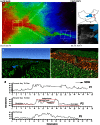Socio-economic impacts on flooding: a 4000-year history of the Yellow River, China
- PMID: 22673799
- PMCID: PMC3472015
- DOI: 10.1007/s13280-012-0290-5
Socio-economic impacts on flooding: a 4000-year history of the Yellow River, China
Abstract
We analyze 4000-year flood history of the lower Yellow River and the history of agricultural development in the middle river by investigating historical writings and quantitative time series data of environmental changes in the river basin. Flood dynamics are characterized by positive feedback loops, critical thresholds of natural processes, and abrupt transitions caused by socio-economic factors. Technological and organizational innovations were dominant driving forces of the flood history. The popularization of iron plows and embarkment of the lower river in the 4th century BC initiated a positive feedback loop on levee breaches. The strength of the feedback loop was enhanced by farming of coarse-sediment producing areas, steep hillslope cultivation, and a new river management paradigm, and finally pushed the flood frequency to its climax in the seventeenth century. The co-evolution of river dynamics and Chinese society is remarkable, especially farming and soil erosion in the middle river, and central authority and river management in the lower river.
Figures






References
-
- An C-B, Tang L, Barton L, Chen F-H. Climate change and cultural response around 4000 cal yr B.P. in the western part of Chinese Loess Plateau. Quaternary Research. 2005;63:347–352. doi: 10.1016/j.yqres.2005.02.004. - DOI
-
- Chi, C.-T. 1936. Key economic areas in Chinese history as revealed in the development of public works for water control. London: Paragon Book Reprint Corp.
-
- Dodgen, R.A. 2001. Controlling the dragon: Confucian engineers and the Yellow River in late imperial China. Honolulu: University of Hawai‘i Press.
-
- Elvin M. The pattern of the Chinese past. Stanford: Stanford University Press; 1973.
MeSH terms
LinkOut - more resources
Full Text Sources
Medical

